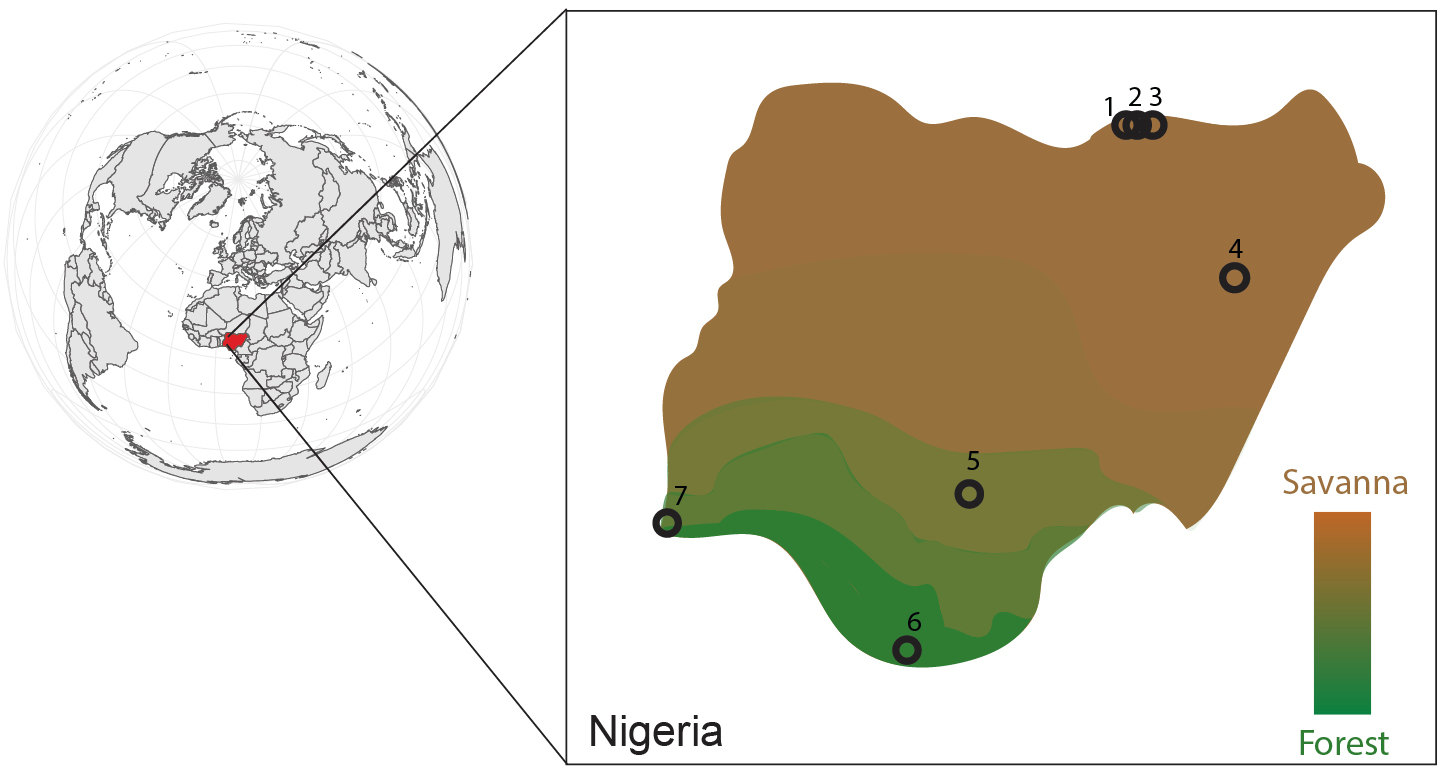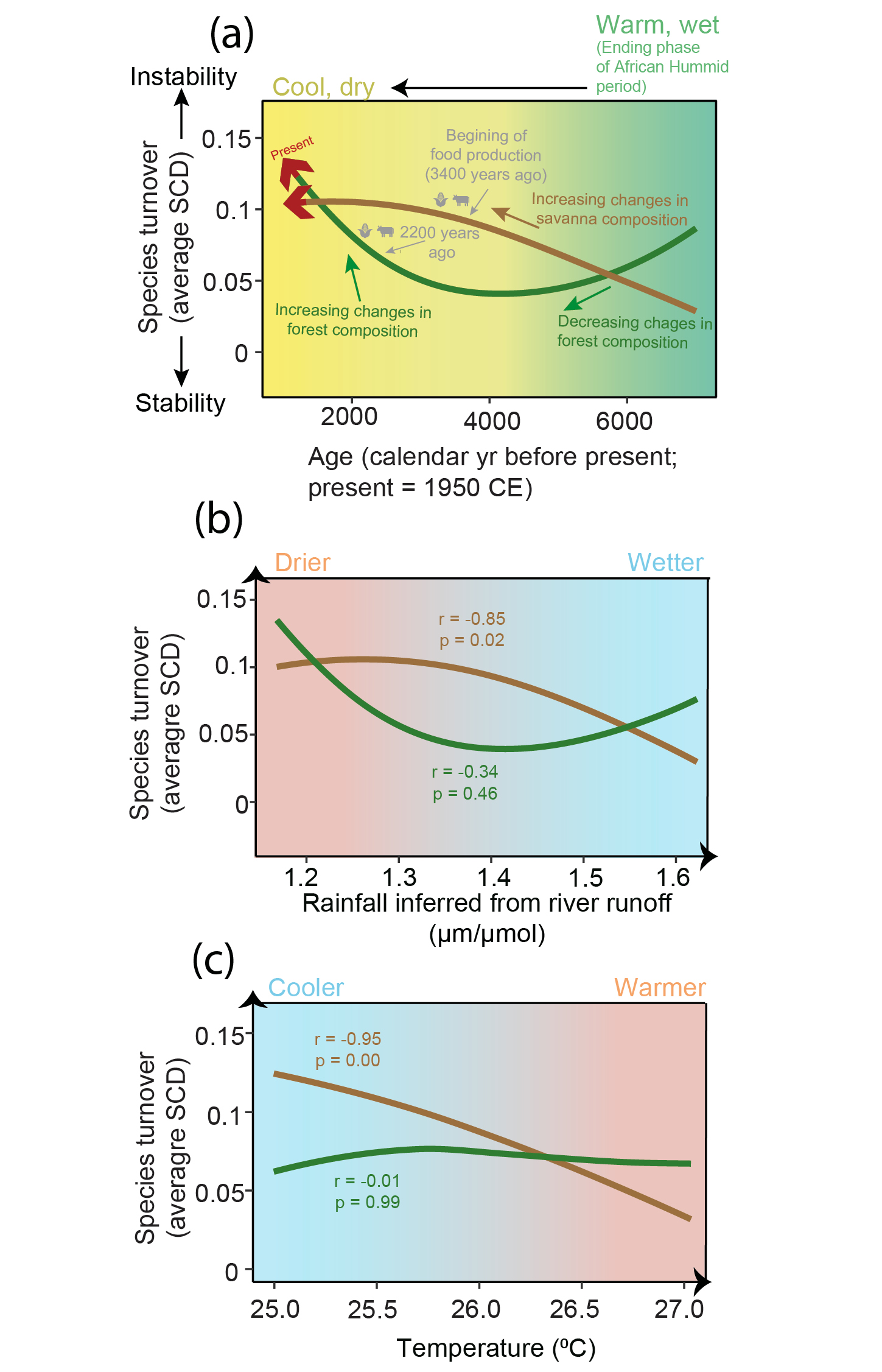- Home
- Publications
- PAGES Magazine
- Using The Knowledge of Past Ecosystem Turnover To Inform Restoration Efforts: A Case Study From Nigeria
Using the knowledge of past ecosystem turnover to inform restoration efforts: A case study from Nigeria
Adeleye MA, Connor SE, Haberle SG and Adeonipekun PA
Past Global Changes Magazine
30(1)
28-29
2022
Using a paleoecological approach, we reveal that recent human activities, rather than natural variations in climate, have caused the greatest changes to Nigerian forests in the last 7000 years. Savanna has shown an even higher climate sensitivity in the past and will likely experience significant changes based on projections of future climate change.
Background
Ecosystem management and conservation challenges are acute in developing nations—including many African countries—as a result of widespread poverty, population growth, and heavy reliance of people on ecosystems for a living (Watson et al. 1997). Nigeria (Fig. 1), which is one of Africa's biodiversity hotspots (Küper et al. 2004), not only has the largest population of any African country (over 200 million), but also the highest number of people living in extreme poverty globally (fao.org; worldpoverty.io). While pervasive human impacts (e.g. agriculture, deforestation, pollution) are the major causes of ecosystem degradation in Nigeria (fao.org), the ecosystems in the region have also been impacted by recent climate changes (Ikumbur and Iornumbe 2019). Understanding the magnitude of ecosystem response (i.e. species turnover) to past climate change and land use can help identify which ecosystems require protection and which areas require urgent conservation/restoration.
Paleoecological records provide reliable ecosystem baseline data for setting conservation, restoration, and management goals (Wingard et al. 2017). This is because paleoecological datasets describe ecosystem patterns and processes over centuries and millennia, which can then be used to develop effective frameworks and strategies for ecosystem interventions (Wingard et al. 2017). However, current baseline data are insufficient in Nigeria to contextualize the long-term regional ecosystem patterns in response to past changes in climate and land use (Eneh 2011). Adeleye et al. (2021a) have used paleoecological datasets to detail the temporal magnitude of vegetation compositional change (turnover) in Nigeria and surrounding western African regions over the last 10,000 years in response to past changes in climate and land use. Here, we compare past turnover in forest and savanna with current rates of change and highlight what the differences mean for ecosystem restoration in the country. To understand the history of present-day ecosystems, we examined Holocene datasets spanning the last 7000 years.
Magnitude of change in Nigeria's forest and savanna
Adeleye et al. (2021a) found that vegetation in many areas of western Africa, including the sites indicated in Figure 1, experienced accelerated turnover in the last 7000 years in response to both climate change and intensified land use. Focusing on records only from Nigeria, savanna in northern Nigeria experienced the overall greatest turnover in the last 7000 years; in contrast, forests in southern Nigeria were relatively stable prior to 2000 years ago (Fig. 2a). A significant (p < 0.05) link between savanna turnover and changes in rainfall and temperature suggests long-term sensitivity of savanna to past climate change, with greatest turnover occurring after the termination of the African Humid Period around 6000–5000 years ago, when conditions became drier and cooler than before. The fact that forest showed little turnover in response to these decreases in precipitation and temperature suggests that forests exhibited long-term resilience (minimal changes in species composition) to past climate changes (Fig. 2a-c). It is also possible that the exploitation of northern Nigerian savanna for food production from ∼3400 years ago contributed to rapid changes in savanna composition during this period (Kay et al. 2019). Food production expanded in southern Nigeria from ∼2200 years ago and would have also contributed to high forest turnover in the last 2000 years (Kay et al. 2019).
Arid to semi-arid terrestrial ecosystems have been identified as susceptible to future climate changes (Watson et al. 1997), and increases in temperature and declines in rainfall have been predicted for northeastern Nigeria (Shiru et al. 2020), where most of the savanna pollen sites are located (Fig. 1). Our paleoecological results show that Nigeria's savanna was sensitive to past rainfall declines after the end of the African Humid Period when the climate was also becoming cooler (Fig. 2b-c). This drought promoted grassland communities (Adeleye et al. 2021a). Considering the current impact (desertification) of warm, dry conditions in Nigeria's savanna (Olagunju 2015), projected climate change will likely intensify drought and its impacts (e.g. species mortality, longer recovery time, shifts in species range) on both grassland and non-grassland communities, leading to further desertification (Sankaran 2019). The increasing trend of intensive agriculture in northern Nigeria may also exacerbate the impact of climate change by suppressing native species recovery after extreme drought events/episodes. This combination seems likely to cause the savanna to enter novel states with greater turnover than anything that has been observed in the last 7000 years (Sankaran 2019; Olagunju 2015).
In contrast to earlier time periods, the last two millennia show highest species turnover in forests, compared to savanna (Fig. 2a). This agrees with modern vegetation mapping and surveys in Nigeria by Abbas et al. (2018), which indicate that forest ecosystems are rapidly changing, and shrinking faster than savanna at 9% and 4%/yr, respectively. Climate change may contribute to recent forest turnover in Nigeria, but the stability of the forests over the last 7000 years in the face of cooling and drought likely indicate that humans were responsible for forest decline and secondary-forest regrowth, especially in the last 2000 years (Kay et al. 2019). Human population density is currently highest in southern Nigeria in rainforest areas, and poverty-related agricultural practices, logging, mining, pollution, and urbanization are known to be causing forest loss and degradation in the region (Abbas et al. 2018; Fasona et al. 2018). Human impacts have likely resulted in major changes in forest composition in southern Nigeria (Fauset et al. 2012), and growing human population pressure will only further exacerbate biodiversity loss and widespread forest replacement through the introduction of novel anthropogenic vegetation.
Implications for ecosystem restoration in Nigeria
The results derived from paleoecological data presented here provide an understanding of long-term resilience and sensitivity of Nigeria's vegetation to drought and human impacts, and this information can assist us in identifying areas of restoration and conservation priority in the country. Our results suggest that recent human land use, rather than natural climate variations, has caused the greatest changes that the southern Nigerian forests have experienced in the last 7000 years. Therefore, effective forest conservation strategies will necessarily involve priority protection from deleterious human land use, especially agriculture, logging, and industrialization, to maintain/increase resilience in existing forest reserves and restore resilience in affected areas. Conversely, climate-sensitive savannas in northern Nigeria should be closely monitored for warning signs of climate-change impacts. Slowing down the rate of savanna transformation may require more complex and carefully designed ecological strategies that go beyond the reduction of intensive agriculture, to consider the high sensitivity of the ecosystem to drought. For instance, conservation strategies should involve a good understanding of savanna ecosystem dynamics across multiple temporal and spatial scales in savannas (Osborne et al. 2018). In addition, any management actions in Nigeria need to take into account their potential impacts on local stakeholders, since conservation gains cannot be sustainable if they come at the cost of human livelihoods.
affiliations
1School of Culture, History and Language, Australian National University, Canberra, Australia
2Australian Research Council Centre of Excellence for Australian Biodiversity and Heritage, The Australian National University, Canberra, Australia
3Department of Botany, University of Lagos, Akoka, Nigeria
contact
Matthew A. Adeleye: matthew.adeleye anu.edu.au
anu.edu.au
references
Abbas II et al. (2018) MOJ Eco Environ Sci 3: 197-205
Adeleye MA et al. (2021a) Holocene 31: 1681-1689
Adeleye MA et al. (2021b) Glob Ecol. Biogeogr 30: 557-571
CBD-UNEP—Convention on Biological Diversity and United Nations Environment Programme (2018)
Eneh OC (2011) J Environ Sci Technol 4: 250-263
Fauset S et al. (2012) Ecol Lett 15: 1120-1129
Ikumbur B, Iornumbe S (2019) Niger J Environ Sci Technol 3: 268-291
Kay AU et al. (2019) J World Prehist 32: 179-228
Küper W et al. (2004) Ann. Missouri Bot Gard 91: 525-535
Osborne CP et al. (2018) New Phytol 220: 10-24
Olagunju TE (2015) J Ecol Nat 77: 196-209
Shiru MS et al. (2020) Sci Rep 10: 10107

